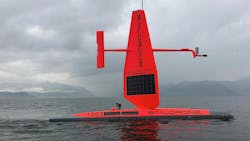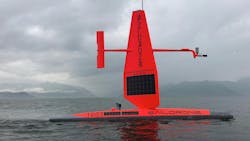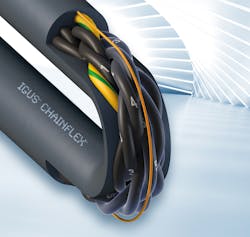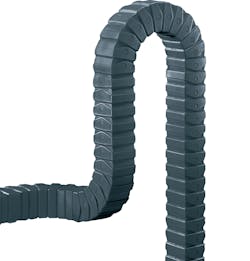Unmanned Sailing Vehicle Tested for Data-Gathering Capabilities
Collecting long-term data on marine plants and animals and tracking temperatures and currents above and below sea level is critical for marine biologist and climate researchers, but it is also expensive. In the past, sending ships loaded with sensors and equipment out for long cruises was about the only way to get long-term data on specific areas. But those cruises cost between $10,000 and $40,000 per day, with the crew being the major cost, according to a 2017 study from Unesco, the scientific research arm of the U.N.
To complicate matters, the U.S. fleet of naval research ships, which are run by the National Oceanic and Atmospheric Administration (NOAA), can only support 50% of the data-gathering missions it wants to and it is losing ships continually as they age out and are not replaced due to costs.
Satellites and buoys are often substitutes for ships, but they have limitations. Buoys can only look at a small area and they still need ships to maintain them. Satellites can’t see beneath the surface of the ocean, and they lack the accuracy and resolution to study what biologists are interested in.
To get around these obstacles, marine scientists are borrowing a page from the aerospace industry, unmanned drones, and adapting them to working on and under the ocean. To ensure drones are a good way to collect marine data, NOAA set up an experiment to compare data collection efforts using autonomous boats to data collected by more conventional research vessels. NOAA chose a drone called Saildrone from a California company of the same name to evaluate drone effectiveness. NOAA used the drones to chart the course of migrating walleye pollack using a sonar tweaked for the task. It is wind powered for propulsion and its sensors, computers and communications rely on solar power.
A SailDrone has a narrow 23-ft (7 m)-long hull, a 16.5 ft meter (5 m) tall stiff wing and a keel with an 8.2 m (2.5) draft. It weighs approximately 1,5653 lb (750 kg) and can be launched and recovered from a dock. It sails using the tall, stiff sail or wing, a longitudinal spar, and a vertical tail. A trim tab on the wing keeps its angle into the wind relatively constant. Average speed is 2.5 knots, top speed is 8 knots, and it can sail 62 miles per day. That means it can reach most ocean locations within 30 days from the closest shore and cover large survey areas.
Using the wind gives the Saildrone a one-year mission length. It can go longer but is limited by marine animals and plants growing on the hull reducing its speed in the tropics and mid-latitudes. In high latitudes, the lack of sunlight in the winter limits the solar power while the ice and sea state slows the drone’s travel. Keeping to a yearly maintenance schedule keeps the drone performing at its best and lets researchers check and change equipment.
The Saildrone can navigate itself from one programmed waypoint to another and stay within proscribed limits, accounting for winds and currents, but for safety it is always under the supervision of a remote human pilot, according to its manufacturer. The pilot controls and monitors the drone via a satellite link.
For safety, the Saildrone carries an automatic identification transceiver, navigation lights, radar reflector and four onboard cameras. It also sports a bright coat of red paint for easier visibility.
Its usual payload measures key atmospheric and oceanographic parameters in real time, including solar irradiance; long-wave radiation; atmospheric pressure; air temperature and humidity; wind speed and direction; ocean surface and bulk water temperature; chlorophyll and colored dissolved organic matter; atmospheric and seawater partial pressure of CO2; dissolved oxygen; salinity; and acidity levels.
The Saildrone have also been equipped with acoustic Doppler current profilers, sonar for biomass assessment and bathymetry surveys, and passive acoustic recorders for marine mammal studies. For the walleye study, the drones carried echosounder sonar units. The sensor package is connected to onboard computers that transmit data via satellite links to shore-based data centers.
To keep the drones light and reduce the maintenance devoted to eliminating and prevent rust, Saildrone was outfitted with plastic assemblies from igus: chainflex data cables and an energy chain. The cables carry data and power to the echosounders and then send data back to the drone over them. Engineers wrapped a thermoplastic elastomer jacket around the cables to protect them from the effects of saltwater.
One drawback of the echosounders is that need to be fairly stable in terms of where they are pointing to get clean sonar images. This means it should be pointing straight down the vast majority of the time. The drone, however, acts like a sailboat and heels over slightly as the wind blows it along.
To eliminate this heeling motion, engineers added a hinged mount to the bottom of the drone and mounted the echosounder on it. They ran a two-foot length of data cable though the energy chain and to the echosounder. The plastic energy chain protects and supports the cable while the sonar twists and rolls on its hinged mount. In this test, the energy chain and cables made sure data and power could reliably travel through them despite an estimated five million bend cycles they went through in the course of a year.
Don Nester is the chainflex cables product manager for igus North America.



